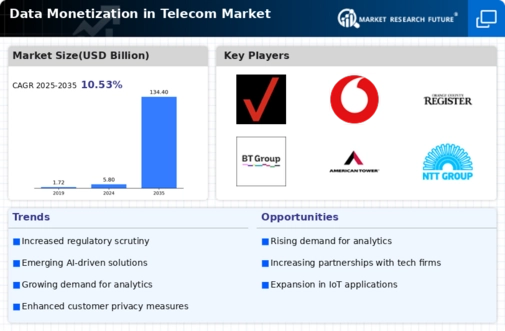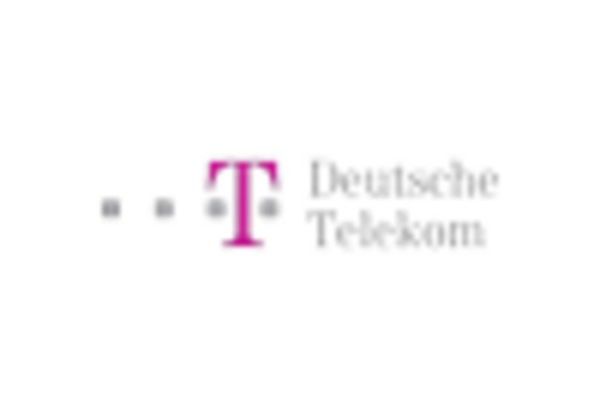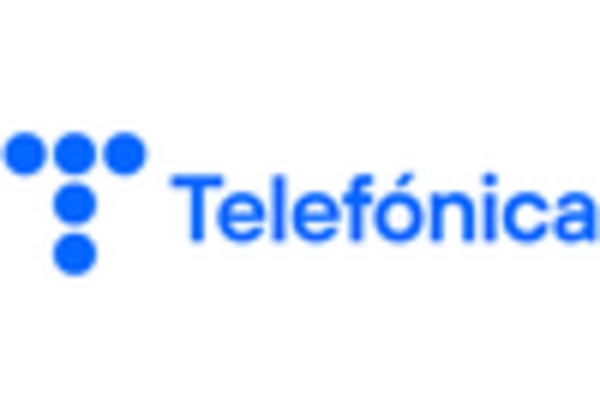Emergence of 5G Technology
The rollout of 5G technology is poised to revolutionize the Data Monetization in Telecom Market. With its promise of ultra-fast connectivity and low latency, 5G enables telecom operators to offer new services that were previously unattainable. This includes enhanced mobile broadband, massive machine-type communications, and ultra-reliable low-latency communications. The global 5G market is projected to reach USD 667 billion by 2026, indicating a substantial opportunity for telecom companies to monetize data generated through these advanced services. By capitalizing on 5G capabilities, operators can create innovative applications and services, thereby driving new revenue streams and enhancing customer experiences. The transition to 5G is likely to accelerate the pace of data monetization initiatives across the industry.
Adoption of IoT and Connected Devices
The proliferation of Internet of Things (IoT) devices is significantly influencing the Data Monetization in Telecom Market. With an estimated 75 billion connected devices expected by 2025, telecom operators are presented with vast opportunities to monetize the data generated by these devices. This influx of data allows for innovative service offerings, such as smart home solutions and connected vehicle services. Telecom companies can analyze usage patterns and provide insights to businesses, enhancing operational efficiency and creating new revenue streams. The integration of IoT into telecom services not only diversifies the product portfolio but also positions operators as key players in the digital ecosystem, fostering partnerships with technology providers and enhancing overall market competitiveness.
Strategic Partnerships and Collaborations
Strategic partnerships and collaborations are becoming increasingly vital in the Data Monetization in Telecom Market. As telecom operators seek to enhance their data monetization strategies, they are forming alliances with technology firms, data analytics companies, and other stakeholders. These collaborations enable telecom companies to access advanced analytics tools and expertise, facilitating the extraction of valuable insights from vast data sets. For instance, partnerships with cloud service providers can enhance data storage and processing capabilities, allowing for more efficient data monetization. This trend is indicative of a broader shift towards collaborative ecosystems, where shared resources and expertise can lead to innovative solutions and improved market positioning. Such strategic alliances are likely to play a crucial role in shaping the future landscape of data monetization in the telecom sector.
Increased Demand for Personalized Services
The Data Monetization in Telecom Market is witnessing a surge in demand for personalized services. As consumers increasingly expect tailored experiences, telecom companies are leveraging data analytics to understand customer preferences and behaviors. This trend is reflected in the growing investment in customer relationship management systems, which are projected to reach USD 80 billion by 2025. By utilizing data monetization strategies, telecom operators can create targeted marketing campaigns and enhance customer satisfaction, ultimately driving revenue growth. The ability to offer personalized services not only improves customer retention but also attracts new subscribers, thereby expanding the market share of telecom companies. This shift towards personalization is likely to continue, as competition intensifies and customer expectations evolve.
Regulatory Changes and Compliance Requirements
The Data Monetization in Telecom Market is increasingly shaped by regulatory changes and compliance requirements. As data privacy concerns grow, telecom operators must navigate complex regulations such as the General Data Protection Regulation (GDPR) and the California Consumer Privacy Act (CCPA). These regulations necessitate robust data governance frameworks, which can be costly but are essential for maintaining consumer trust. Companies that proactively adapt to these regulations can leverage compliance as a competitive advantage, ensuring that their data monetization strategies align with legal standards. This focus on compliance not only mitigates risks but also enhances the reputation of telecom operators, potentially leading to increased customer loyalty and market share.


















Leave a Comment